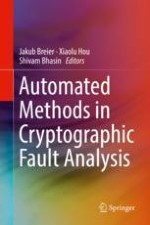2019 | OriginalPaper | Buchkapitel
2. ExpFault: An Automated Framework for Block Cipher Fault Analysis
verfasst von : Sayandeep Saha, Debdeep Mukhopadhyay, Pallab Dasgupta
Erschienen in: Automated Methods in Cryptographic Fault Analysis
Aktivieren Sie unsere intelligente Suche, um passende Fachinhalte oder Patente zu finden.
Wählen Sie Textabschnitte aus um mit Künstlicher Intelligenz passenden Patente zu finden. powered by
Markieren Sie Textabschnitte, um KI-gestützt weitere passende Inhalte zu finden. powered by
